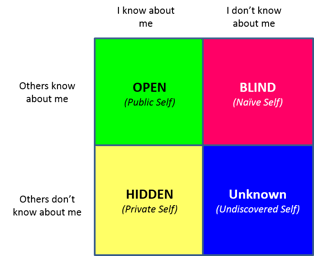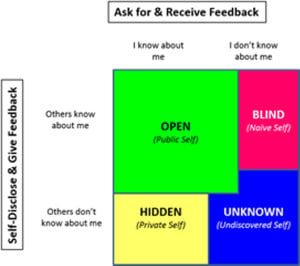
As Agile Coaches, we help teams grow and mature. But there’s no how-to manual that tells us how to do that. So how do we accomplish it?
Today I’ll talk about a model I find useful when working with teams. The “Johari Window” model was developed by Joseph Luft and Harry Ingham in the 1950’s from their work with groups. “Johari” comes from a mash-up of “Joe” and “Harry.
What is it?
The Johari Window is a simple model, a tool that can help build trust and improve interpersonal relationships within a group by increasing self-awareness and mutual understanding, and improving communications.
Johari’s Window has 4 quadrants:
 OPEN
OPEN
The public self or open persona.
This quadrant represents what you know about yourself that others also know about you (includes behavior, knowledge, skills, attitudes, strengths, weaknesses, etc). This is the self we share with others.
BLIND
The blind self or naïve persona.
The blind area represents what is known by others, but you are unaware or don’t know about. We can’t access the positive things in this area because we don’t know about them, and negative aspects that we don’t know about make us vulnerable.
HIDDEN
The private self or secret persona.
This quadrant presents what you know about yourself, but keep hidden from others. These are the things that make us uncomfortable or that we’re not confident in.
UNKNOWN
The undiscovered self or mysterious persona.
The unknown area represents what is unknown by you and unknown by others. This dark area is where our deepest fears and buried talents reside.
The model is based on two fundamental concepts:
- Trust and growth can result from being open
- Awareness and self-development can result from asking for feedback
How is it used?
Johari’s Window can be used from an individual, team, work group, or project perspective. The ultimate goal is to increase the “open” quadrant….expanding the public self, and reducing the hidden, blind, and unknown areas.
Opening this window is accomplished by:

- Telling others about yourself…..willingly sharing your thoughts and intentions. The more people know about us – how we think, what’s important to us, how we make decisions – the more cooperatively, collaboratively, and effectively we work together. The sharing here refers to things that are appropriate for the environment, e.g., sharing intimate details isn’t appropriate at work, and would not have a positive effect on relationships in this setting.
- Asking others for honest feedback….on how they experience you and what impact your behavior etc has on them. Be open to receiving feedback, as it’s a way for us to learn what others see but we don’t, highlighting opportunities for growth.
It’s important to acknowledge here that the word feedback has a negative connotation in American culture. That’s because feedback is usually couched as “friendly advice” about what we’re doing wrong, or delivered in a context of judgement and intimidation, e.g., “you’re wrong/broken, and you need to fix this or else”. So we fear it.
But feedback is really about the person giving it, not about the person receiving it. Most of us have good intentions; we do what we think is right, for the right reasons, and are unaware that others might receive it differently than we intended. Feedback isn’t about us being wrong or broken, but rather a way for others to tell us our impact on them. It is a gift….ours to do with what we want.
- Introspecting regularly….regularly looking inside, honestly assessing what we want, how we behave, what we have to offer, what we need to develop, and increasing our self-awareness.
- Challenging ourselves….take more risks, expand boundaries, solve bigger problems, work with different people, or execute on a bigger stage. This will tap into and reveal our deepest fears and help us discover unknown strengths.
So what do I do next?
Whether you’re using the Johari Window model for as an individual or for a team, the key is the more developed the “open” area is, the more comfortable, happy, successful, and collaborative we’re likely to be.
Stay tuned for my next installment where I’ll talk about crafting a team retrospective using concepts around the Johari Window.
Send me your comments…..I’d love to hear your questions, experiences, and ideas for helping teams grow.
More from the blog
View All Blog PostsSubscribe to Our Blog
Fill out your email address to receive notifications about new blog posts from CC Pace!
